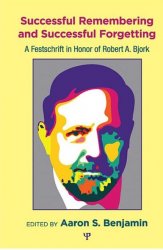Successful Remembering and Successful Forgetting
- Добавил: rabinio
- Дата: 30-05-2021, 10:48
- Комментариев: 0
 Название: Successful Remembering and Successful Forgetting
Название: Successful Remembering and Successful ForgettingАвтор: Benjamin Aaron S
Язык: English
Издательство: Taylor & Francis
Год: 2010
Формат: pdf
Кол-во страниц: 583
Размер: 46 мб
The desirable difficulties perspective (E. L. Bjork & Bjork, 2011; R. A. Bjork, 1988, 1992; Bjork & Bjork, 2006; R. A. Bjork & Linn, 2006) and the region of proximal learning framework (e.g., Kornell & Metcalfe, 2006; Metcalfe, 2002, 2009; Metcalfe & Kornell, 2005) appear, at least on the surface, to be at odds. The desirable difficulties perspective says that individuals should make things hard on themselves (but in a good way). Instructors should not spare the learners, but instead they should challenge them and make learning difficult. People should embrace difficulties, because it is through those difficulties that long-term learning occurs. The term desirable is added to difficulties, but even so the message is that learning should be a challenge. The region of proximal learning framework proposes that learning is optimized by having the learner study materials that are not very difficult, given the individual’s current state of learning. Indeed, they should be the easiest possible as-yet-unlearned items—just beyond what the learner has already fully mastered, but not much beyond. Too much difficulty, within this framework, is seen as maladaptive and potentially disheartening.
Both of these views are intuitive. The desirable difficulties perspective capitalizes on the adage “no pain, no gain” and on the pervasive work ethic emphasizing the moral value of hard work and diligence that many cultures claim for their own. The region of proximal learning framework resonates with the developmental philosophies of Piaget (1952) and Vygotsky (1987), including the idea that there is a zone of proximal development that is just beyond what the child is capable of easily on his or her own, in which he or she could learn via scaffolding. It also conforms to the transitional learning stage in Atkinson’s (1972) Markov model, in which items that are not yet permanently learned, but rather are in a state of being almost learned, are those on which the learner should concentrate. It takes seriously the so-called labor in vain effect of Nelson and Leonesio (1988) whereby people may spend a great deal of time selectively working on the most difficult items, but this extra time and effort is without payoff. It results in no memory benefit. In the world of education, the region of proximal learning framework resonates to the notion of “just right” books for children in which their own reading level is assessed and then they are given books very close to their own skill level. Allowing children to read at their own level is thought to promote fluency and faster, not slower, progress. It is also thought to make reading more enjoyable and less frustrating. The adage that comes to mind for the region of proximal learning framework is that it is sensible to first take the “low-hanging fruit.”
The apparent conflict between the desirable difficulties and the region of proximal learning views does not do justice to either framework, however. Both are more nuanced than such a simplistic overview would suggest.
Внимание
Уважаемый посетитель, Вы зашли на сайт как незарегистрированный пользователь.
Мы рекомендуем Вам зарегистрироваться либо войти на сайт под своим именем.
Уважаемый посетитель, Вы зашли на сайт как незарегистрированный пользователь.
Мы рекомендуем Вам зарегистрироваться либо войти на сайт под своим именем.
Информация
Посетители, находящиеся в группе Гости, не могут оставлять комментарии к данной публикации.
Посетители, находящиеся в группе Гости, не могут оставлять комментарии к данной публикации.
